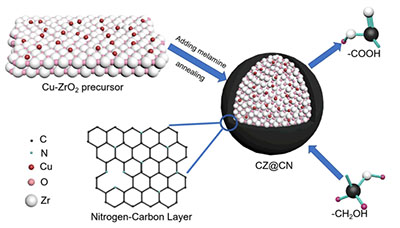| [1] Zhu, Y.; Kong, X.; Li, X.; Ding, G.; Zhu, Y.; Li, Y. W. ACS Catal. 2014, 4, 3612.
[2] Duan, Z. K.; Li, S.; Xie, F.; Yan, J. H.; Zhang, T. Chem. Res. Appl. 2015, 27, 417. (段正康, 李晟, 谢帆, 闫建华, 张涛, 化学研究与应用, 2015, 27, 417.)
[3] Tang, Q. L.; Liu, Z. P. J. Phys. Chem. 2010, 114, 8423.
[4] Agrell, J.; Birgersson, H.; Boutonnet, M.; Melián-Cabrera, I.; Navarro, R. M.; Fierro, J. L. G. J. Catal. 2003, 219, 389.
[5] Huo, J. P.; Song, H. H.; Chen, X. H.; Zhao, S. Q.; Xu, C. M. Carbon Techniques. 2006, 25, 22. (霍俊平, 宋怀河, 陈晓红, 赵锁奇, 徐春明, 炭素技术, 2006, 25, 22.)
[6] Liu, J. Y.; Yang, P. J.; Zhang, J. F.; Ma, S. J. Petrochem. Technol. 2004, 33, 330. (刘金河, 杨普江, 张景峰, 马淑杰, 石油化工, 2004, 33, 330.)
[7] Li, H. T.; Chen, H. R.; Zhang, Y.; Gao, C. G.; Zhao, Y. X. Chinese J. Catal. 2011, 32, 111. (李海涛, 陈昊然, 张因, 高春光, 赵永祥, 催化学报, 2011, 32, 111.)
[8] Roy, R. K.; Lee, K. J. Biomed. Mater. Res. B 2010, 83B, 72.
[9] Zhang, Z. Q.; Ge, C. X.; Chen, Y. G.; Wu, Q.; Yang, L. J.; Wang, X. Z.; Hu, Z. Acta Chim. Sinica 2019, 77, 60. (张志琦, 葛承宣, 陈玉刚, 吴强, 杨立军, 王喜章, 胡征, 化学学报, 2019, 77, 60.)
[10] Su, D. S.; Zhang, J.; Frank, B.; Thomas, A.; Wang, X.; Parak-nowitsch, J.; Schlögl, R. ChemSusChem 2010, 3, 169.
[11] Mabena, L. F.; Sinha Ray, S.; Mhlanga, S. D.; Coville, N. J. Appl. Nanosci. 2011, 1, 67.
[12] Dai, X. Q.; Zhu, Y. B.; Xu, X. L.; Wen, J. Q. Chin. J. Org. Chem. 2017, 37, 577. (戴小强, 朱亚波, 许孝良, 翁建全, 有机化学, 2017, 37, 577.)
[13] Watanabe, H.; Asano, S.; Fujita, S.; Yoshida, H.; Arai, M. ACS Catal. 2015, 5, 2886.
[14] Zhang, P.; Wang, Q. N.; Yang, X.; Wang, D.; Li, W. C.; Zheng, Y. P.; Chen, M. S.; Lu, A. H. ChemCatChem 2017, 9, 505.
[15] Shi, R. N.; Zhao, J. X.; Liu, S. S.; Sun, W.; Li, H. X.; Hao, P. P.; Li, Z.; Ren, J. Carbon 2018, 130, 185.
[16] Wen, Z.; Liu, J.; Li, J. Adv. Mater. 2008, 20, 743.
[17] Unnikrishnan, P.; Srinivas, D. Ind. Eng. Chem. Res. 2012, 51, 6356.
[18] Hu, Q.; Yang, L.; Fan, G. L.; Li, F. Chem. Nano. Mat. 2016, 2, 888.
[19] Wang, J.; Lei, Z.; Qin, H.; Zhang, L.; Li, F. Ind. Eng. Chem. Res. 2011, 50, 7120.
[20] Hu, Q.; Fan, G.; Yang, L.; Cao, X.; Zhang, P.; Wang, B.; Li, F. Green Chem. 2016, 18, 2317.
[21] Xu, J.; Shen, K.; Xue, B. J. Mol. Cayal. A 2013, 372, 105.
[22] ABUDUHEIREMU, Awati; Zhang, D. D.; HALIDAN, Maimaiti Chem. J. Chin. Univ. 2019, 40, 306. (阿卜杜黑热木·阿瓦提, 张得栋, 哈丽丹·买买提, 高等学校化学学报, 2019, 40, 306.)
[23] Chen, S.; Bi, J.; Zhao, L.; Yang, C.; Ma, Y.; Wu, Q.; Wang, X.; Hu, Z. Adv. Mater. 2012, 24, 5593.
[24] Sharitfi, T.; Hu, G.; Jia, X.; Wagberg, T. ACS Nano 2012, 6, 8904.
[25] Wang, X. X.; Zhang, L. H.; Lin, H. J.; Nong, Q. Y.; Wu, Y.; Wu, T. H.; He, Y. M. RSC Adv. 2014, 4, 40029.
[26] Yang, Y.; Duan, Z.; Liu, W. Chem. Reac. Eng. Technol. 2001, 17, 210.
[27] Balaraman, E.; Khaskin, E.; Leitus, G.; Milstein, D. Nat. Chem. 2013, 5, 122.
[28] Neurock, M.; Tao, Z.; Chemburkar, A.; Hibbitts, D. D.; Lglesia, E. Faraday Discuss. 2017, 197, 181. |
